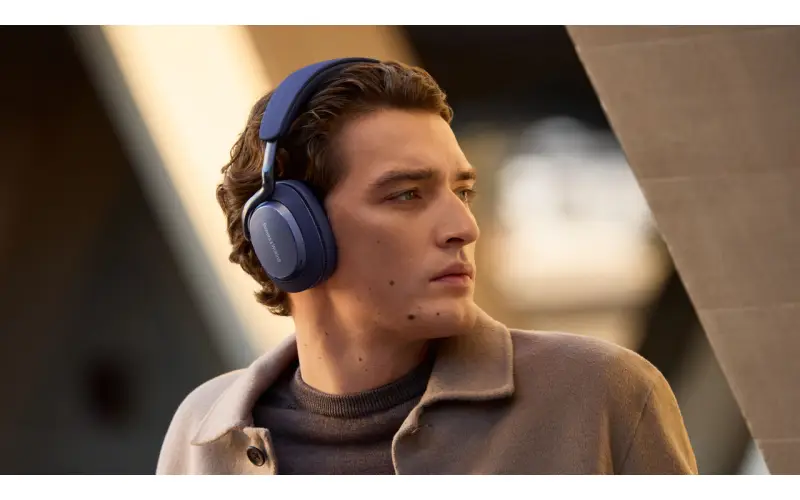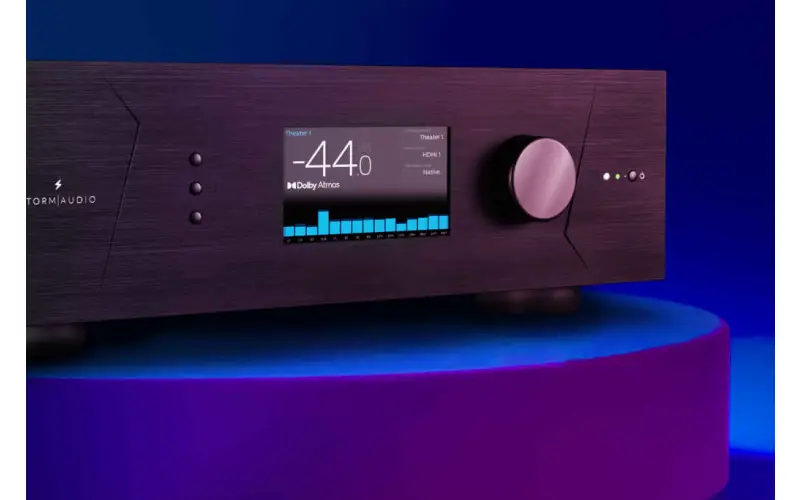By: Dipin Sehdev
Bowers & Wilkins is no stranger to high-end audio. From reference-class loudspeakers in Abbey Road Studios to award-winning headphones that blend hi-fi acoustics with modern convenience, the British brand has carved out a loyal following among audiophiles and casual listeners alike. Now, in 2025, Bowers & Wilkins is back with its latest flagship wireless noise-canceling headphone: the Px7 S3.
Succeeding the highly acclaimed Px7 S2e—which notched a stellar 92% CE Critic Score and received praise for its balance of sonic fidelity and noise-canceling prowess—the Px7 S3 represents a generational leap in both hardware and design. With re-engineered drivers, a discrete headphone amplifier, revamped noise cancellation, and support for aptX Lossless and spatial audio, the Px7 S3 isn't just a refinement—it's a reinvention.
Let’s break down what’s new, what’s improved, and whether these headphones are worth your money.
Sleeker, Slimmer, Smarter Design
One of the most noticeable changes is visual—and physical. The Px7 S3 sports a slimmer profile, a redesigned headband, and newly contoured arm mechanics that help the headphones sit closer to your head. This not only improves the aesthetic but enhances long-term comfort, reducing fatigue during extended listening sessions.
Bowers & Wilkins has also redesigned the memory foam earpads, making them softer and more adaptive, while the new travel case is more compact than previous generations, making it easier to toss the Px7 S3 into a backpack or carry-on.
The headphones are available in three premium finishes:
-
Anthracite Black
-
Indigo Blue
-
Canvas White
Better still, both the earpads and headband are now replaceable, a move toward sustainability and longer product life.
All-New Drivers and a Dedicated Amplifier
Under the hood, the Px7 S3 is a technical powerhouse. At its core are brand-new 40mm biocellulose dynamic drivers, engineered with a revamped chassis, voice coil, magnet, and suspension. The only component carried over from the Px7 S2e is the cone material—everything else has been reimagined for lower distortion, greater dynamic range, and improved sonic detail.
These new drivers are angled toward your ears for optimal stereo imaging and spatial realism, a design element borrowed from Bowers & Wilkins' high-end loudspeakers.
For the first time in a B&W over-ear headphone, the Px7 S3 includes a dedicated discrete headphone amplifier. This helps deliver a more expansive and energetic presentation, particularly noticeable in dynamic tracks where transient detail and spatial depth matter most.
Codec Support: aptX Lossless, Adaptive & More
If you're a high-res audio fan, the Px7 S3 doesn’t disappoint.
It supports:
-
aptX Adaptive
-
aptX Lossless
-
AAC
-
SBC
The inclusion of aptX Lossless—though limited to Android devices that support it—promises near-CD quality playback over Bluetooth, without lossy compression. Note, however, that aptX Lossless is highly dependent on connection strength and only works with a handful of Android phones as of 2025. Samsung and Google phones, for example, still lack official support.
And let’s be real: no Bluetooth codec today offers true hi-res lossless transmission. What the Px7 S3 does is get closer to that goal than most.
For the purists, wired options are available. Bowers & Wilkins includes:
-
USB-C to USB-C cable for high-resolution digital audio
-
USB-C to 3.5mm cable for analog listening
This makes the Px7 S3 equally comfortable plugged into a DAC, laptop, or even the latest iPhone (which no longer has a headphone jack but supports USB-C audio).
Active Noise Cancellation: New Circuit, More Mics
The Px7 S3 raises the bar for ANC performance with a re-engineered eight-microphone array.
Here's how it breaks down:
-
2 mics measure driver output (for adaptive correction)
-
4 mics monitor external ambient noise
-
2 mics focus on voice clarity
All microphones work in concert with ADI’s Pure Voice technology, which enhances vocal pickup and suppresses unwanted background noise during phone calls.
Microphone placement and tuning have been refined to ensure effective performance in high-noise environments, whether you're commuting or on a long-haul flight.
Battery Life: 30 Hours with Fast Charging
Battery life remains a strong point:
-
30 hours with ANC enabled
-
15-minute charge yields 7 hours of playback
That’s plenty for all-day use or a week’s worth of commuting. And if you're ever in a pinch, the rapid charging feature is a game-changer.
New Controls, New App Features
Physical button lovers, rejoice. B&W continues to support on-headphone tactile controls:
-
Volume Up / Down
-
Play / Pause
-
Power (now moved to the left earcup)
-
Quick Action (configurable for ANC or voice assistant)
The layout has been adjusted for improved tactile interaction, making it easier to control without pulling out your phone.
Meanwhile, the Bowers & Wilkins Music app (iOS and Android) unlocks deeper functionality:
-
Switch between ANC modes (On / Off / Pass-through)
-
Customize Quick Action button
-
Adjust five-band EQ and save presets
-
Toggle True Sound mode (the default tuning from B&W’s Southwater Research Establishment)
Later this year, the app will also deliver two major firmware updates:
-
Spatial Audio Support
A proprietary spatial processing algorithm is coming to the Px7 S3, aimed at delivering a natural, immersive listening experience—not artificial head-spinning effects. -
Bluetooth LE Audio & Auracast
This will enable support for LC3, a next-gen codec that’s more efficient and potentially higher quality than SBC.
Auracast, meanwhile, will let a single device broadcast to multiple headphones simultaneously—a potential game-changer for public spaces or shared listening.
How Does It Compare to Px7 S2e?
Let’s not forget the Px7 S2e was no slouch. Its 92% CE Critic Score was well-deserved, thanks to excellent sonic tuning, reliable ANC, and refined design.
Here’s a quick comparison chart:
| Feature | Px7 S2e | Px7 S3 |
|---|---|---|
| Driver Type | 40mm biocellulose | Redesigned 40mm biocellulose |
| Amplifier | Integrated | Discrete headphone amp |
| ANC Microphones | 6 | 8 (incl. call-clarity mics) |
| aptX Lossless | ? | ? |
| Spatial Audio | ? | ? (via update) |
| Bluetooth LE Audio | ? | ? (via update) |
| App EQ | 3-band | 5-band + presets |
| Battery Life | 30 hrs | 30 hrs |
| Charging Speed | 15 min = 7 hrs | 15 min = 7 hrs |
| Price | $399 | TBD |
Availability and Pricing
The Bowers & Wilkins Px7 S3 availability and pricing will be announced at a later date.
Final Verdict: Should You Buy the Px7 S3?
The Px7 S3 is more than an iterative update—it's a full-scale revamp that takes an already excellent product and improves almost every aspect. From driver design to noise cancellation, wireless codec support to future-proof features like spatial audio and Auracast, Bowers & Wilkins has crafted a headphone that competes head-to-head with Sony’s WH-1000XM5, Apple’s AirPods Max, and Sennheiser’s Momentum 4.
If you care about audio fidelity, appreciate a premium build, and want a pair of ANC headphones that’s as future-ready as it is great-sounding right now, the Px7 S3 belongs at the top of your wishlist. We look forward to the reviews and CE Critic Score.
Stay tuned for the Px8 S2, which is expected to land later this year.
| Feature | Bowers & Wilkins Px7 S3 | Apple AirPods Max | Sony WH-1000XM5 |
|---|---|---|---|
| Driver Size/Type | 40mm biocellulose, angled | 40mm dynamic (custom Apple) | 30mm dynamic |
| Amplifier | Discrete headphone amp | Integrated | Integrated |
| Noise Cancellation | 8-mic hybrid ANC (adaptive) | ANC with H1 chips | Dual processor ANC |
| Bluetooth Codecs | aptX Lossless, Adaptive, AAC, SBC | AAC only | LDAC, AAC, SBC |
| Spatial Audio | Yes (via update, 2025) | Yes (Dolby Atmos + tracking) | Yes (360 Reality Audio) |
| Bluetooth Version | Bluetooth 5.2 + LE Audio (via update) | Bluetooth 5.0 | Bluetooth 5.2 |
| Battery Life (ANC On) | 30 hours | 20 hours | 30 hours |
| Fast Charging | 15 min = 7 hrs | 5 min = 1.5 hrs | 3 min = 3 hrs |
| App EQ Customization | 5-band EQ + presets | None | Full parametric EQ |
| USB-C Audio Support | Yes | No | Yes |
| Weight | 307g | 385g | 250g |
| Price (USD) | TBD | $549 | $399 |





